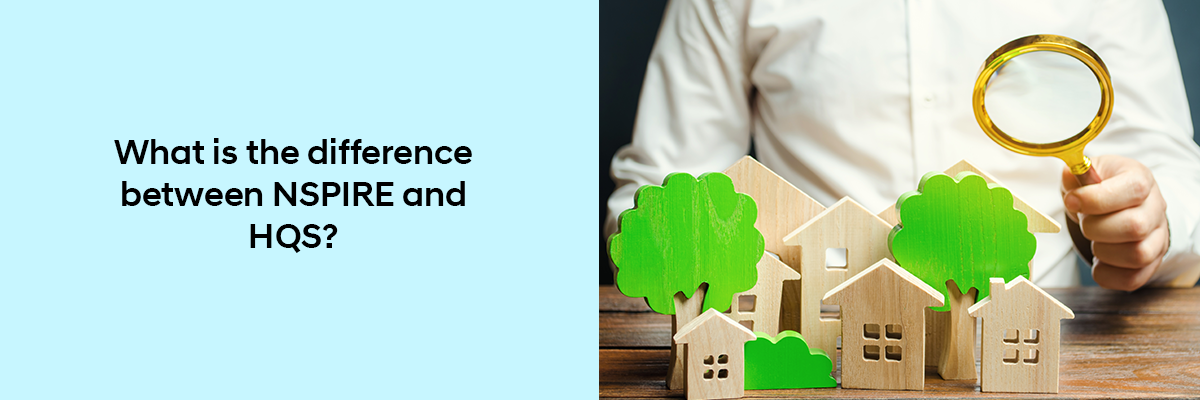When it comes to federally subsidized housing in the United States, two primary inspection standards are employed: NSPIRE (National Standards for the Physical Inspection of Real Estate) and HQS (Housing Quality Standards). Both systems are designed to ensure that housing is safe, habitable, and suitable for tenants, but they have distinct differences in their scope, methodology, and application.
In this blog, we’ll explore the key differences between NSPIRE and HQS, how they each impact housing inspections, and why NSPIRE is poised to replace HQS as the modern standard for housing quality assessments.



So, like this blog, we host informative webinars on topics such as affordable housing, construction, fair housing, and other related subjects. These webinars are valuable resources for property managers, landlords, and homeowners, helping them better understand the rules and regulations. By attending, they can ensure their properties are in compliance with legal standards, properly maintained, and in the right condition for their tenants—ultimately helping them avoid any potential issues. Do check our fair housing webinar webpage.
Difference between HQS and NSPIRE
So, to understand the difference between the two, we have highlighted a few points to differentiate them. Which might help you understand the difference between the two.
1. Purpose and Context
HQS: The Traditional Standard
The Housing Quality Standards (HQS) were established by the U.S. Department of Housing and Urban Development (HUD) to set the minimum standards for housing in programs like the Housing Choice Voucher Program (Section 8). The goal of HQS is to ensure that rented homes are free of hazards and are habitable for tenants. These standards have been in place for decades, primarily focusing on basic safety and sanitary conditions.
HQS inspections are used to inspect a range of housing conditions in low-income housing programs. The focus is on making sure the housing meets basic needs like functional plumbing, heating, safe electrical systems, and overall structural integrity.
Example:
An inspector checking a unit under HQS will look for things like:
- Safe electrical systems (e.g., ensuring no exposed wires or faulty outlets).
- Adequate plumbing (e.g., ensuring that faucets, toilets, and drains function properly and there are no leaks).
- No safety hazards (e.g., ensuring there are no broken stairs, sharp objects, or exposed nails).
NSPIRE: A Modern and Comprehensive Approach
NSPIRE, which stands for the National Standards for the Physical Inspection of Real Estate, is a newer initiative by HUD designed to streamline housing inspections across all federally assisted housing programs. NSPIRE aims to promote more consistent, outcomes-based inspection protocols that go beyond merely ensuring the safety of the housing to actively improving the quality of life for tenants.
NSPIRE Protocol is focused on evaluating the health, safety, and functional living conditions of residents, offering a more holistic and modern approach to inspections.
Example:
Under NSPIRE, inspectors would not just check that plumbing works; they might also evaluate whether the plumbing system is efficient, whether it contributes to long-term health concerns like waterborne diseases, or whether it’s capable of accommodating the needs of a family of four. The focus is more on the outcomes of the housing conditions.
2. Inspection Criteria
HQS: Prescriptive and Checklist-Driven
HQS inspections are based on a prescriptive list of standards and criteria. The inspection process is highly structured, and inspectors must check off each requirement on the list to determine if the unit is in compliance.
HQS uses 13 key performance areas, covering everything from basic sanitation to structural safety. These areas ensure that the property meets minimum standards for the physical condition of the building.
The 13 key performance areas of HQS include:
- Sanitary Facilities – Ensures toilets, sinks, and other sanitation systems are functional.
- Food Preparation and Refuse Disposal – Evaluates kitchen cleanliness and the effectiveness of garbage disposal.
- Space and Security – Looks at the overall space available and the security of the property.
- Thermal Environment – Ensures the heating system is functional and that the unit is adequately insulated.
- Illumination and Electricity – Inspects for electrical and lighting deficiencies to ensure they are safe and functional.
- Structure and Materials – Evaluates the physical integrity of the structure (e.g., walls, floors, roof).
- Interior Air Quality – Assesses ventilation and the quality of the indoor environment.
- Water Supply – Checks for a safe and clean water supply.
- Lead-Based Paint – Ensures there is no risk of lead poisoning, particularly in homes built before 1978.
- Access – Ensures tenants can easily access the property.
- Site and Neighborhood – Evaluates the general condition of the neighborhood and surrounding areas.
- Sanitary Condition – Assesses cleanliness and hygiene of the property.
- Smoke Detectors – Checks for functional smoke alarms.
Each of these criteria must meet a specific standard for the unit to pass inspection.
NSPIRE: A More Comprehensive, Outcomes-Focused Approach
While HQS uses a prescriptive checklist, NSPIRE adopts a more outcome-focused approach. Instead of merely listing whether a specific item meets a standard, NSPIRE focuses on the health and safety outcomes that result from these standards.
NSPIRE organizes its standards into three main categories:
- Health and Safety – Evaluates conditions that could harm the tenant’s well-being, such as mold, pests, or fire safety deficiencies.
- Functionality – Assesses whether systems and equipment (heating, plumbing, etc.) are working properly and meeting the needs of the tenants.
- Operability – Ensures that all appliances, doors, windows, and other essential fixtures are functioning as intended.
This change in focus allows inspectors to assess the effectiveness of the systems in place and how they contribute to the overall livability of the space, which is not something HQS directly addresses.
Example:
In NSPIRE, the inspector might evaluate whether the heating system is not just functional but also energy-efficient and able to provide comfort during the winter months, thus reducing health risks from extreme cold.
3. Scoring and Outcomes
HQS: Pass/Fail System
HQS inspections operate on a pass/fail basis. If a unit fails any of the required criteria, it cannot be approved for use under HUD programs until all deficiencies are addressed. This is a simple and direct way of evaluating compliance, but it doesn’t account for the severity of the violations.
NSPIRE: Scoring System
NSPIRE introduces a scoring system that assigns a point value to different deficiencies based on their severity and frequency. This provides a more nuanced understanding of housing quality.
Example:
Under NSPIRE, a minor issue, such as a leaky faucet, might score lower, while a serious issue, such as a broken furnace, would result in a much higher score. This scoring helps prioritize repairs based on urgency and overall impact on the residents’ health and safety.
4. Frequency of Inspections
HQS: Annual Inspections
Under HQS, inspections are typically conducted once a year. This ensures that the housing meets the minimum standards, but it doesn’t account for any changes that might have occurred in the interim.
NSPIRE: Risk-Based Scheduling
NSPIRE employs a more dynamic approach to inspection frequency, using risk-based scheduling. This means that properties with a history of non-compliance or those with lower scores may be inspected more frequently, while properties that consistently meet standards might face inspections less often. This approach helps to allocate resources more efficiently and reduce unnecessary inspections.
5. Technology Integration
HQS: Traditional Methods
HQS inspections are largely manual. Inspectors use paper checklists and often rely on traditional reporting methods, which can introduce human error and inefficiencies.
NSPIRE: Digital and Data-Driven
NSPIRE integrates modern technology, such as digital tools for inspection and data analytics to assess housing conditions. This not only improves the accuracy and consistency of inspections but also helps in tracking long-term trends in housing quality.
Conclusion
To summarize, while HQS provides a checklist-based, pass/fail system designed to ensure basic health and safety, NSPIRE takes a more holistic and modern approach by focusing on the outcomes of housing conditions, using scoring systems and risk-based scheduling. As housing needs evolve, NSPIRE is poised to replace HQS with a more consistent, comprehensive, and data-driven approach that addresses both the immediate and long-term needs of tenants.
With NSPIRE’s focus on health, functionality, and operability, it aims to provide better living conditions and a more responsive approach to property management, making it the ideal framework for the future of housing inspections in federally subsidized programs.


